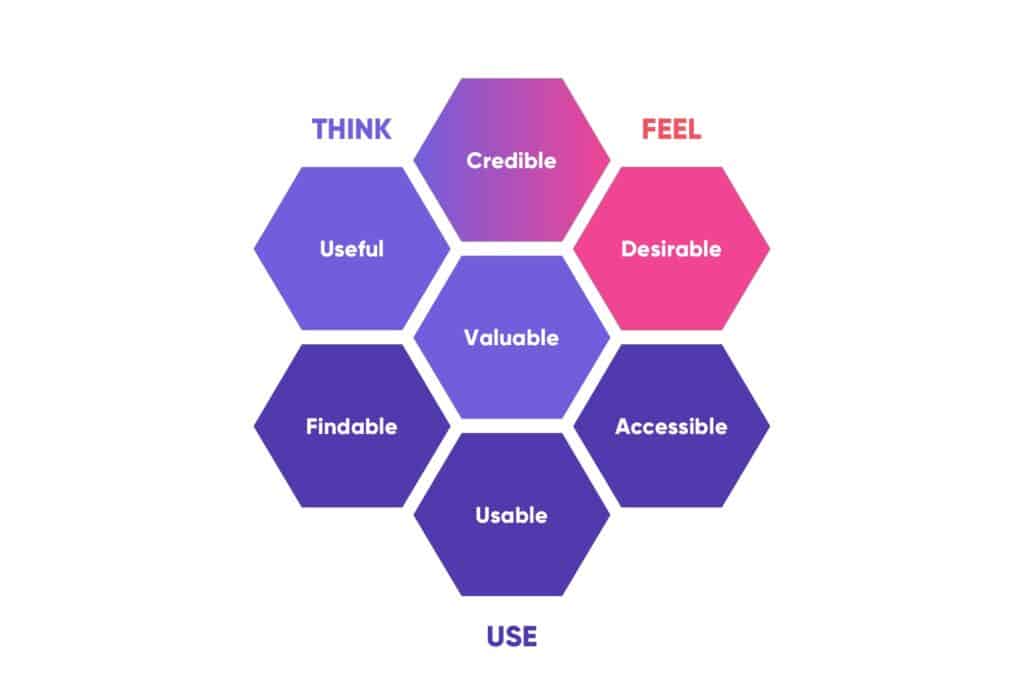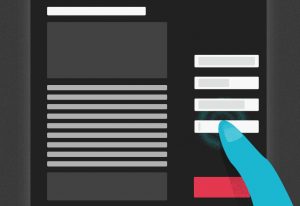Have you ever purchased a product or signed up for a service that sounded amazing on paper but was actually confusing to use in practice? If so, then you already have an idea why UX design is important.
UX stands for “user experience” – the experience of what it’s actually like to interact with a particular product or brand. Nail the UX design attached to a particular product or web experience, and you potentially have a hit on your hands. Miss the boat, and an otherwise great product could easily fail.
But what is UX design and why is it important? How can you be sure you’re adequately integrating UX design into your product designs and digital experiences? Let’s take a closer look at what you need to know to get it right.
- What Is UX Design and Why Is It Important?
- What Are the Principles of Great UX Design?
- How to Kickstart an Effective UX Design Process
- Consider leveraging user personas
- Zero in on user journeys
- Optimize your experience for multiple devices
- Keep brand assets consistent
- Integrate clear calls-to-action (CTAs)
- Check and test load times
- The Importance of Building a Reliable UX Design Team
What Is UX Design and Why Is It Important?
The concept of user experience (UX) is fairly broad and can cover any interaction a particular user might have with a brand, product, or service offering. Various factors that can affect user experience in one way or another include:
- How products look, as well as how they’re packaged or presented
- How different product features make the user feel
- How users interact with the product during real-time use
Generally speaking, good UX design ensures every aspect of how a user connects with a product goes smoothly, feels intuitive, and is positive from start to finish. Additional reasons why UX is important can include:
It facilitates better workflow
The better and more intuitive the design and implementation, the more natural the process of using a product will be for the end user. Great UX design simplifies the use process, makes it intuitive, and makes it possible for users to complete tasks quickly and easily.
It keeps overall production costs low
Getting user experience correct right out of the gate lowers the possibility of having to take a product back to the drawing board later. This can save a company a fortune in time, labor, and funds.
It boosts your return on investment (ROI)
The easier your product is to use, the more your customers will ultimately use it. You stand a good chance of them wondering how they ever lived without it, leading to future purchases, glowing recommendations, and more.
It improves your reputation
Sleek good looks may get a customer’s initial attention, but it’s ultimately user experience that decides whether a positive first impression will stick. Brands that can make that happen are brands that develop stellar reputations for excellence, user-friendliness, and quality.
What Are the Principles of Great UX Design?
Positive, streamlined user experiences never go out of style. But what it means to deliver one changes along with the field, so product designers and marketers need to keep up.
Thankfully, the fundamentals of a great UX design generally stay consistent over time. Here are key examples to know when designing new products and experiences or troubleshooting existing ones.
Humanize your experiences
Everyone knows what it’s like to interact with an app, software suite, or other product that feels like it has zero personality behind it – cold, boring, and uninviting. Great design leverages ways to show the personality and human energy behind a brand, drawing the user into the experience in the process.
Make the user journey intuitive
Every product or experience has a different learning curve attached to it, but a larger learning curve should never actually feel large. Good UX design avoids overwhelming users and never leaves them wondering where they are on their personal journey. It serves as a guide that’s there for them every step of the process.
Offer a consistent experience
The more straightforward, approachable, and consistent you can be with the experiences you offer your audience, the better. Someone familiar with what your brand is all about should feel confident that they’ll always get the same positive user experience, whether using your products or consuming content on your company blog.
Keep it simple and concise
Experiences designed with UX in mind don’t beat around the bush or waste anyone’s time. The average consumer attention span these days clocks in at around eight seconds, so getting to the point is a must. This is the case whether you’re talking about the built-in tutorial for your new app or the latest how-to guide to hit your website.
Make it easy to find
Great content, products, websites, and experiences are more than just fantastic once you discover them. They’re also easy to find and navigate in the first place, especially when it comes to web experiences. Embracing ways to blend SEO and UX can help you take your website, blog content, and online experiences to the next level and beyond.

The UX Honeycomb, created by Peter Morville, is like a roadmap for creating stuff people love. Right in the middle is the golden nugget: value. Everything around it—like usability, reliability, and how it looks—matters too. Imagine having a killer website that’s super valuable and looks amazing, but it’s like a hidden treasure in a dark corner of the internet. Or a platform that’s valuable and good-looking but is a pain to use. Not cool. But remember, the key is nailing that value part. People can cut some slack if your thing is super valuable, even if it’s not perfect in every other way. It’s like the captain of the team, holding it all together.
How to Kickstart an Effective UX Design Process
Whether you’re developing your next product line, putting together a new website, or planning your next batch of informative blog posts, you want to keep user experience in mind right from the get-go. This is especially the case when it comes to the design process.
Paying attention to UX design is an effective way to honor today’s “human first” approach to everything from SEO to digital product design. Here are key tips for getting started in the right direction.
Know your users’ pain points
Before you can get to work improving the user experience attached to your site or digital products, you need to understand what isn’t working or at least could use a little polish. That means developing a deeper understanding of your users’ initial expectations and how well your product is or isn’t meeting them.
Consulting existing data you may have about how your users interact with your brand and products can be helpful. But a fresh round of user outreach can lead to deeper, more helpful insights you can use. Some methods to consider include the following:
- Surveys are solid ways to gather feedback from large groups of people. Compile a concise list of survey questions that get to the heart of what you want to know. Consider offering incentives for completing the survey where it makes sense.
- User interviews and run-throughs that involve watching users interact with an experience in real time can be helpful, as well. These can be conducted either in person or remotely.
Social media, on-site feedback forms, and similar options can be helpful, as well. Analyze your collected feedback for important insights and apply them to your UX design process.
Consider leveraging user personas
Another solid way to leverage user data to facilitate improvements in UX design is to use it to create user personas (also sometimes referred to as buyer personas). Personas are semi-fictional profiles that represent your ideal end users and prospective customers.
Among other things, user or buyer personas can help you improve UX by:
- Making it easier to move into your end user’s head when designing or revamping digital experiences
- Streamlining communication between all members of your creative team, including designers, copywriters, marketers, and so forth.
- Ensuring supporting content is on point and on target in every way it needs to be
- Ensuring experiences meet the evolving expectations of the people they’re intended for
Be sure to regularly update your collection of personas to ensure it remains reflective of your actual user base. Once a year is a good general rule of thumb to follow. However, it’s also recommended to perform a fresh review if there are significant changes regarding your target audience or the general market.
Zero in on user journeys
Every user is unique. However, personas can help you sort yours into specific segments, each with its own typical habits, preferences, and behavioral patterns. Once you understand what behaviors are typical for different types of users, you can start to piece together user journeys and boost UX design as a result.
Identify what the primary goal is for each of your users when it comes to interacting with your website, products, and experiences. Consider the possible paths they might follow in pursuit of their goals, and ensure your established design actively facilitates all of them.
The idea is to create an experience that’s so intuitive and feels so natural to a user that they don’t hit any obstacles or feel the need to seek out assistance. Label elements clearly, ensure navigation is seamless, and carefully consider factors like information hierarchy.

Optimize your experience for multiple devices
The days when people only shopped, searched for information or accessed their favorite digital products via a laptop or old-school desktop system are over. Yes, people absolutely still use those devices. However, most also access digital assets and websites via their smartphones, tablets, and multiple other devices.
That said, optimizing your digital experiences for multiple screens is an important part of thorough UX design. Ensure the actual use experience is consistent across all potential interfaces, including your main website, your mobile website, your apps, and so forth.
The average user should be able to seamlessly switch from one access point to another without the experience feeling different in any major way. Don’t forget to design responsively so assets display well on a variety of different screen sizes, as well.
Keep brand assets consistent
Although usability should definitely be your top priority, don’t underestimate the influence visual consistency can have on overall user experience. Part of providing a seamless user experience is ensuring everything feels familiar, especially to long-time members of your target audience.
Iconography, color themes, fonts, and patterns should be considered givens – elements your audience has learned to associate with your brand identity over time. However, that consistency should also extend to terminology, tone of voice, and brand personality. Your users should instinctively know who they’re dealing with when they access any of your experiences.
Integrate clear calls-to-action (CTAs)
Calls-to-action are simple but powerful ways to help guide a user toward their end goal. Artfully incorporating them into your UX design approach is a solid way to ensure people can find their way around. Effective CTAs:
- Use clear, action-oriented language
- Leverage contrasting colors to help them stand out
- Are easily clickable
- Are visually appealing and easy to spot
Calls-to-action work well across all of your digital assets. These include apps, software, digital products, downloadable ebooks, blog content, email marketing content, etc.
Check and test load times
Speed is everything when it comes to today’s fast-paced digital landscape, so be sure you’re considering load times when it comes to UX design. Your users do expect a fast response and may go elsewhere if you don’t deliver.
For websites, an ideal loading time in 2024 is under two seconds – well under, if possible. However, load times matter when it comes to software and other digital experiences, as well. The goal should be instantaneous responsiveness across the board.
The Importance of Building a Reliable UX Design Team
Reliable, effective UX design isn’t a one-person job. The bigger your brand and the more expansive your range of digital experiences, the more important it is that you have a full team of collaborators to turn to for results.
Important benefits attached to assembling a UX team include but are not limited to:
- Access to a collective pool of varied expertise and experience
- Faster results that don’t leave your audiences waiting
- Affordable assistance that makes the most of your design budget
- Higher-quality experiences that better meet rising user expectations
Naturally, any good UX design team should include content creators, copywriters, designers, and other creative professionals. You can connect with some of the best and brightest when you make WriterAccess your go-to source for elite, experienced freelance help with your ongoing UX needs.
Try WriterAccess free when you sign up for your free 14-day WriterAccess trial today! You’ll love the difference the right help can make.








